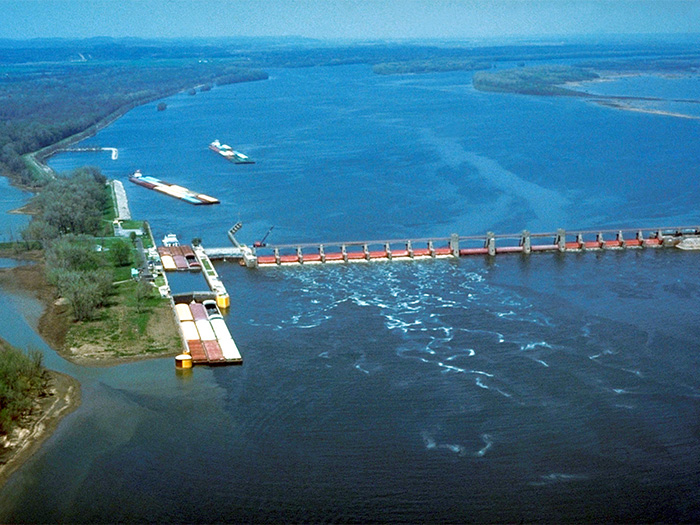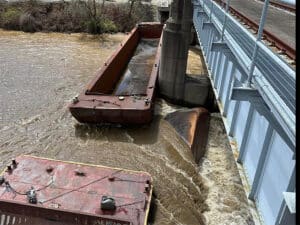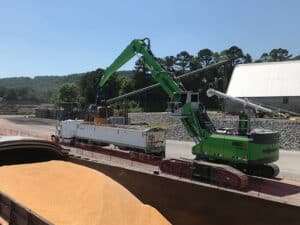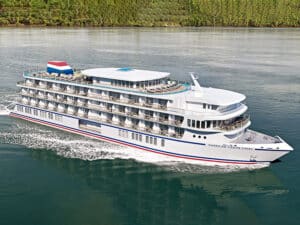
Congressional push for Corps action of NESP on Mississippi River
Written by Nick Blenkey
Construction at Lock and Dam 25 will result in a new 1,200 foot x 110 foot lock chamber being built adjacent to the existing 600 foot chamber. [USACE photograph]
A bipartisan group of members of Congress has written the U.S. Army Corps of Engineers urging that it prioritize funding for construction of the Navigation and Ecosystem Sustainability Program (NESP) on the Upper Mississippi River (UMR) system.
Members of Congress signing the letter include Sen. Chuck Grassley (R-Iowa) ] Senate Majority Whip Dick Durbin (D-Ill.) and Sen. Roy Blunt (R-Mo.), along with Reps. Cheri Bustos (D-Ill.-17) and Ashley Hinson (R-Iowa-01). Eight additional senators and 39 representatives have also signed on.
While the Infrastructure Investment and Jobs Act that was recently signed into law provides $2.5 billion funding for the inland waterway system as a category, work remains to ensure funding is specifically allocated to a number of the lock and dam projects—including Lock and Dam 25, LaGrange Lock and Dam, and Lock and Dam 24—that have lingered for years waiting for needed investment.
FARM ORGANIZATIONS STEP UP
In effort to get things moving, a group of farmer-funded and farmer-led organizations—the United Soybean Board, the Soy Transportation Coalition, the Illinois Soybean Association, the Iowa Soybean Association, the Iowa Corn Promotion Board, the Minnesota Soybean Research and Promotion Council, and the Missouri Soybean Merchandising Council—have offered $1 million to help underwrite the cost of pre-engineering and design expenses of Lock and Dam 25. The contribution would be contingent upon the Army Corps of Engineers – the government agency responsible for maintaining locks and dams—being able to accept funding from private sector entities for such projects.
Located in Winfield, Mo., Lock and Dam 25 was opened in 1939 is the most southern lock and dam on the Mississippi River with a single, 600- by 110-foot lock chamber. Almost every shipment of soybeans, corn, and other grain transported along the Mississippi River from the states of Illinois, Iowa, Minnesota, Missouri, and Wisconsin passes through Lock and Dam 25 en route to export facilities near the Gulf of Mexico.
According to the the Soy Transportation Coalition, if Lock and Dam 25 project proceeds to construction, it would be the first construction project within the NESP. The NESP program calls for the construction of seven new locks – five north of St. Louis on the Upper Mississippi River and two on the Illinois River (LaGrange and Peoria).
Construction at Lock and Dam No. 25 would result in a new 1,200- by 110-foot lock chamber being built adjacent to the existing 600- by 110-foot lock chamber. This would enable a typical 15 barge tow to transit the lock in one single pass (a 30-45 minute process) compared to disassembling the barge tow into two sections, which will result in two passes (over two hours). In addition, a second lock will provide needed resiliency and redundancy—allowing a key link in the supply chain to remain operational if one of the lock chambers was closed.
ECONOMIC BENEFITS OF NESP
“The regional and national economic benefits of NESP are significant, which is why the project was included in the December 2020 Inland and Intracoastal Waterways Twenty-Year Capital Investment Strategy (CIS) developed by the Corps and the Inland Waterways User Board (IWUB). Following the 2020 CIS including NESP construction will bring immediate financial and environmental benefits throughout the system that will reverberate through the economy,” the lawmakers wrote.
Originally authorized in Title VIII of the Water Resources Development Act of 2007, NESP would modernize and expand seven outdated locks at the most congested lock locations along the Upper Mississippi and Illinois Rivers as well as fund more than $1 billion in ecosystem restoration. NESP will create almost 50 million person-hours of living wage construction jobs. A 2019 study released by the U.S. Department of Agriculture showed that rebuilding NESP locks would inject $72 billion additional dollars into the nation’s GDP.
Read the letter below:




